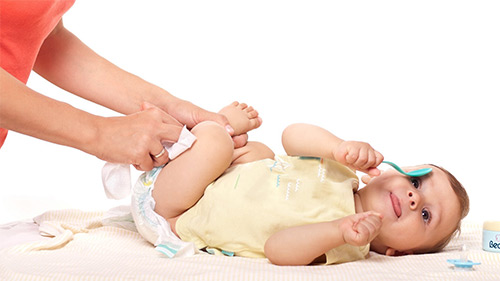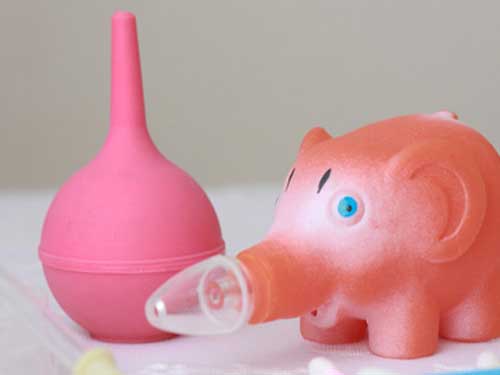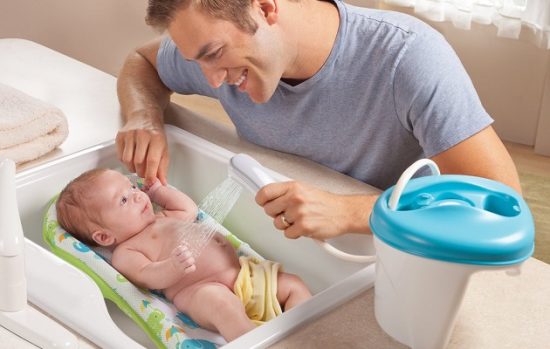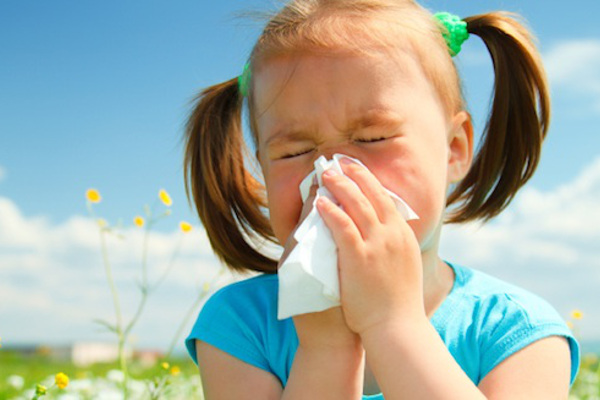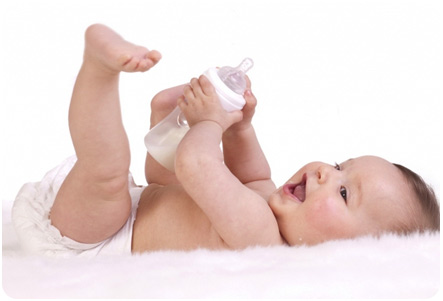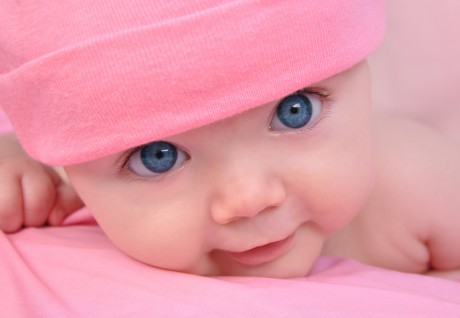Content
- How to change baby diapers
- Baby Care: How to Wash the Baby
- How to treat an umbilical wound in a baby
- How to care for baby hair
- How to trim the nails of a baby
When a baby appears in the house, young parents need to learn a lot. Such seemingly simple things as changing a diaper, or bathing, raise new questions among new parents.
How to change baby diapers
Proper use of disposable diapers. To begin with, diapers should be purchased in small quantities to check if the baby is allergic and this model is suitable for him. It is necessary to change diapers for newborn babies of the first months of life every 2.5-3 hours (nighttime is no exception) or every time the baby urinates or defecates.
If it’s not important for the boy how to remove the diaper, then for the girl, due to the structural features of the genitals, it is important to observe the following recommendations. With a girl, the diaper, especially after a bowel movement, should be removed by moving from the pubis to the anus (rectum), unfastening the side clasps, so that there is less risk of entering the feces into the vagina. Then the child needs to be washed under running water using baby soap, and if the baby just urinated – just water.
When washing the boy, you can place the tummy down on the hand, and the girl – tummy up, so that the stream of water flows from front to back. Then the baby’s ass and legs should be blotted with a clean towel or diaper and placed on a flat surface to put on the diaper. If possible, it is advisable to take air baths so that the skin in the perineum can “breathe”.
Before putting on the diaper, if the child has reddening of the skin, you can treat the folds (inguinal and gluteal) with cream “under the diaper” (just such a marking you can see on the packaging). If the umbilical wound has not yet healed, before putting on the diaper, it is necessary to tuck its upper front edge so as not to injure the wound. Many manufacturers of diapers have taken care of this, having made a cutout on the diaper in the navel for the models for newborns.
If it is not possible to wash the child before changing the diaper (for example, in the clinic), you can use special baby wipes. However, their use should not be systematic: they cannot, as thoroughly as washing, cleanse the skin of urine and bowel movements.
Baby Care: How to Wash the Baby
Daily procedures – washing, cleaning the nose and ears. Often these procedures cause difficulties for young parents: the first few times the baby may protest against hygiene procedures, and mom or dad are afraid that they will hurt the baby. In fact, these actions, when properly performed, are safe and simple. Let’s start with the preparations. You will need:
· A bowl of boiled water at room temperature (22-25 ° C);
· Cotton balls, which can be rolled up from ordinary sterile cotton wool, or ready-made cotton balls;
· Cotton flagella, also rolled up from ordinary sterile cotton wool (roll a cotton ball between your fingers, you get a kind of spindle, this is a flagellum);
· Saline drops in the nose (AQUAMARIS, AQUALOR or physiological saline (0.9% sodium chloride solution);
· Small waste bin.
Wash the baby right.
To make the procedure pleasant for the child, place it in a warm room (air temperature 20-22 ° C) and place the baby on a flat surface (for example, a changing table), place everything you need at arm’s length, so as not to leave the baby.
Take a cotton ball or cotton pad, soak it in boiled water and wipe the baby’s eyes from the outer corner to the inner one: this movement prevents infection.
For the second eye, repeat the procedure with another ball or disc. No need to rub the eyes of the child, if they have discharge. Just wipe them with a few damp balls until the eyes are clean. At the end of the procedure, wipe the entire face of the baby with another cotton pad soaked in boiled water.
How to clean your baby’s nose
If there are crusts in the nasal passage of the crumbs to soak them and moisturize the mucous membrane, drip 2-4 drops of salt drops (drops based on sea water) or physiological saline into each nasal passage. Wait 30-60 seconds. Then take a cotton flagellum and with a twisting motion insert approximately 1-1.5 cm into the baby’s nostril: this helps to remove mucus and crusts. For the second nostril, do the same with the other flagellum. If there are no crusts in the baby’s nose, there is no need to pre-instill saline. The use of cotton swabs is unacceptable for cleaning the nose: they can cause injury to the delicate nasal mucosa, as babies cannot lie still and can twist their heads during the procedure.
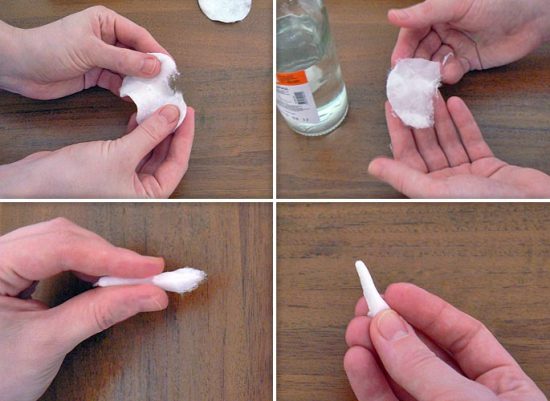
During the procedure, the child may begin to sneeze. This is not dangerous: in this way it cleans the nose of mucus or soaked crusts. Simply wipe the mucus from the nose with a clean cloth or soft, disposable paper tissue. You can also use a special vacuum to clean your nose..
How to clean your baby’s ears
It is necessary to moisten a cotton ball in boiled water and wipe the auricle, all curls and the area of entry into the ear canal. At the end of the procedure, you need to wipe the fold area behind the ears. If the skin is too dry there, it is permissible to lubricate it with baby cream.
Do not use cotton swabs for cleaning: they can injure the ear canal of the crumbs. In addition, you should not try to deeply clean the ear canal. Sulfur in the ear constantly moves due to the cilia to the exit of the ear canal and performs a protective function, preventing microbes from entering the ear. Therefore, it is not necessary to clean it from the depth of the aisle. After completing the water procedures, you can slightly dampen your skin with a soft cotton towel.
How to bathe the baby
Bathing. The skin of the baby is the largest organ of excretion and metabolism, therefore it is extremely important to maintain it in constant cleanliness. The baby needs to be bathed daily, and in hot weather or with excessive sweating of the baby – even twice a day. Choose a time for swimming so that the child is in a good mood, 45-60 minutes after eating. Many parents bathe the baby before bedtime, it is permissible to do this in the morning, after feeding.
The first days, before the healing of the umbilical wound, the baby should be bathed in boiled water or in water with a slightly pink solution, and then in ordinary warm water. It is recommended to prepare a potassium permanganate solution in advance by dissolving several crystals of manganese in 1 liter of water. It turns out a saturated solution, which is gradually added to the bath until a slightly pink color of water is obtained. Strain this solution through a bandage folded in several layers. This is necessary in order to avoid a burn of the delicate skin of a crumb by a poorly soluble manganese crystal (this can happen if the solution is prepared directly in the bath itself). The remaining concentrated solution is stored until the next bath in the refrigerator with a tightly closed lid..
Choose the water temperature so that your back of your hand is comfortable; usually it is 36-38 ° С. Once a week, the procedure is carried out using soap or shampoo for children, and for daily bathing take ordinary water. More frequent bathing with soap is not recommended, as any soap rinses off the protective lipid film from the skin and dries it. Adding herbs, especially a string of chamomiles or oak bark, is used only on the recommendation of a pediatrician. Their independent use is not recommended, as they greatly dry the skin, which can lead to irritation. Once or twice a week, it is necessary to wash the baby’s head with shampoo or a special foam for children, and the rest of the time it’s enough to wash the head with running water while swimming.
After bathing, it is recommended to pour the baby from the bucket or jug with water of slightly lower temperature: this is an element of hardening and stimulates the metabolism. Then you need to wrap the baby in a bath towel, get wet your skin and hair and put on clean clothes.
Up to 3-6 months, it is not recommended to use the usual “adult” bath for bathing the baby – it is better to bathe the baby in a special baby bath. This is necessary not only for hygienic purposes, but also for the safety of the crumbs, because in an adult bath there is no way to fix a special bathing slide that supports the baby’s head and shoulders, preventing it from slipping under the water (and from the hands of the mother supporting the baby’s head while bathing it can slide easily).
The baby bath can be placed in the bathroom or in the children’s room so that mom or dad are in a comfortable position; it can provide special stands for a baby bath. As already mentioned, special bathing slides are currently being sold, which are installed in a baby bath. Such slides support the baby’s head and shoulders in an elevated position, which prevents it from slipping under water and frees both hands of the parent to bathe the baby. In any case, you cannot leave the child alone in the bath for a second, even if it is located on a hill.
How to treat an umbilical wound in a baby
Treatment of the umbilical wound. The umbilical wound must be properly looked after, and then it will heal in time, up to 10-14 days. How to do this correctly, mother is usually told back in the hospital, with the help of a children’s nurse, the mother processes the baby’s navel for the first time. At home, the wound is treated until it is completely healed. Usually this procedure is carried out twice a day – in the morning after waking up and in the evening after swimming.
You will need:
·cotton buds;
· Hydrogen peroxide solution;
· Solution of diamond greens or alcohol solution of chlorophyllipt
· Small waste container.
Put everything you need in advance in the place where the treatment will be carried out, at arm’s length, since you cannot leave the baby alone and turn away from it.
It is necessary to moisten a cotton swab in a solution of hydrogen peroxide and thoroughly soak all the crusts until the hiss stops and there are no bubbles. Thus, the wound is cleaned of germs and dying cells that form the crust, and the skin in the umbilical wound becomes accessible to oxygen. Forcibly crusts are better not to separate. After using the peroxide, wet the navel area with a cotton swab. After that, treat the umbilical wound and the area around it with a solution of brilliant green or an alcoholic solution of chlorophyllipt. When putting on clothes and a diaper, make sure that the gum or parts of the clothes do not rub on the navel and do not injure the wound. Gluing the navel with adhesive tape or applying various bandages to the navel area is not recommended: the skin should “breathe”, then the wound will heal quickly.
How to care for baby hair
Hair and fontanel care of the baby. Many parents care about the question: will combing and washing the baby’s head harm the fontanel? Is it possible to touch it?
The fontanel is a connective tissue membrane at the junction of the bones of the skull; it is strong enough, it cannot be damaged by ordinary procedures. A large fontanel is located in the Temech region: it is formed at the junction of two parietal and frontal bones. The posterior, or small, fontanel is formed at the junction of the parietal and occipital bones. Typically, the small fontanel is closed to birth or in the first weeks of life, and the large fontanel closes by an average of 12 months. The fontanel does not require any special care.
It is not difficult to take care of the baby’s hair: you can comb them with special brushes with soft bristles. Combs and adults are not recommended to use combs: they can injure the delicate skin of the scalp.

If the child has a tendency to allergies, milk crusts may appear on the head – gray-yellow formations in the region of the little girl with hair growing from them. Previously, there was a recommendation to comb these peels, soaking in oil. Currently, it has been proven that such procedures only injure irritated and inflamed skin under the crust, which leads to their re-formation in even greater numbers. Therefore, the crusts are simply removed when washing the head with light massaging movements. To do this, when applying shampoo to your hair with fingertips, lightly rub the place of the crust, then part of the crust will get wet and come off. Forcibly rip off or comb them out is not worth it. Crusts gradually go down to 9-10 months.
How to trim the nails of a baby
Cutting the nails of the baby. Many parents are afraid of the first time to cut the nails of the child, but you need to do this after discharge from the hospital regularly, as they grow much faster than in adults. In addition, the baby can injure itself with the nails when moving the handles, so once a week they need to be cut short. The method of cutting nails is somewhat different on the fingers and toes, and the procedure is performed only by special children’s non-scissors with rounded ends.
On the hands, the nails are trimmed along the growth line of the marigold, with a rounding at the corners. If burrs form on the fingers, they are carefully cut with scissors and treated with a solution of hydrogen peroxide.
On the legs, the nails are often injured due to motor activity, and to prevent the ingrowth of the corners of the nails and their breaking off, it is recommended to cut the nails in a straight line without cutting the corners. In case of reddening in the area of the nail or ingrowth of part of the nail into the skin, it is recommended that after bathing, carefully push the skin in the area of the nail with a wooden spatula for manicure and treat the redness with hydrogen peroxide. In addition, you need to regularly treat the baby’s scissors: they can be rinsed with boiling water or thoroughly wiped all parts with a solution of alcohol.







